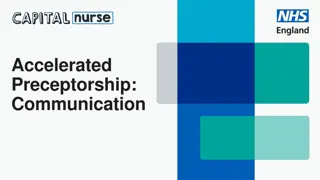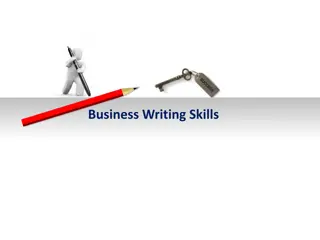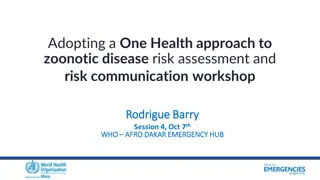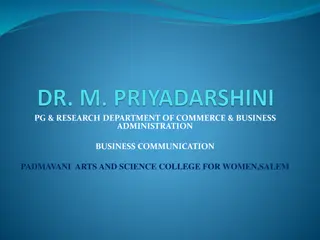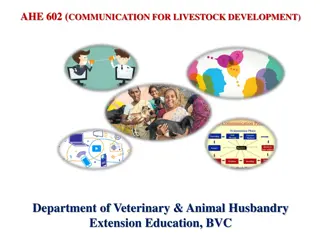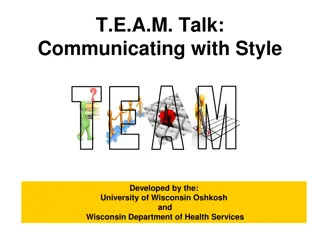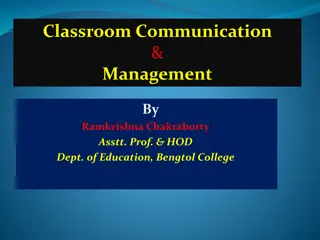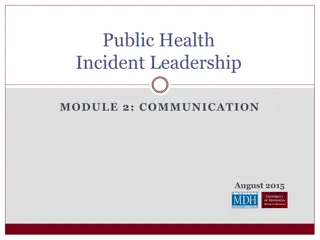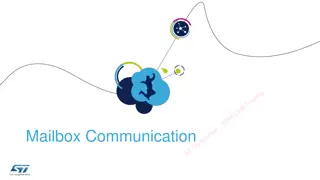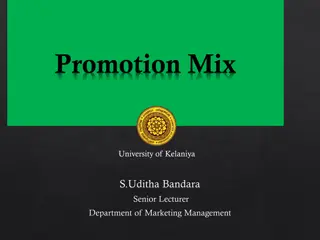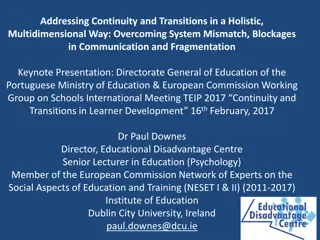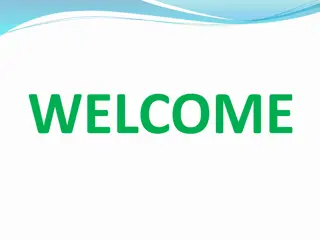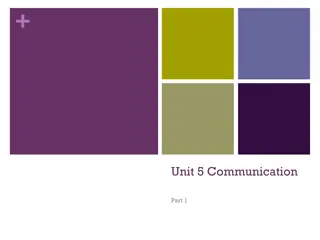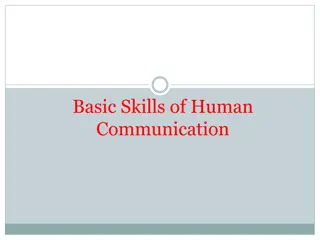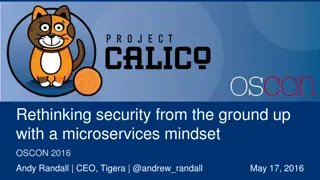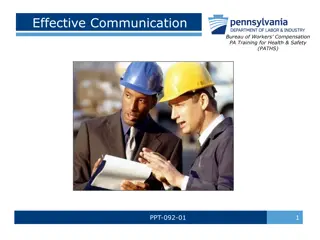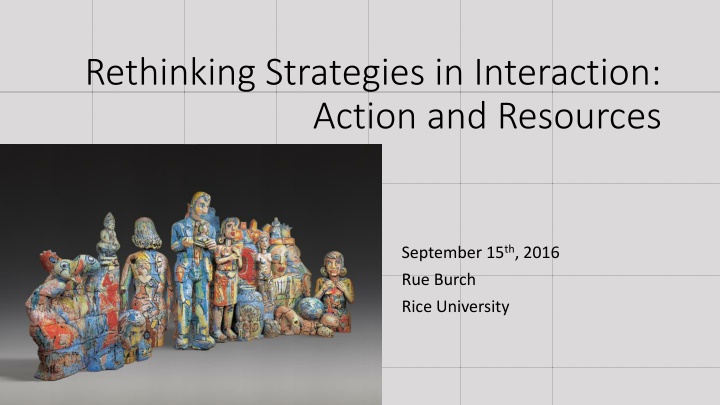
Rethinking Strategies in Interaction and Communication
Explore the concept of communication strategies and their implications for language teaching and learning. Engage in discussions on interactional competence, resources, and the role of strategies in communication. Dive into various perspectives on teaching and assessing communication strategies in second language acquisition research.
Download Presentation

Please find below an Image/Link to download the presentation.
The content on the website is provided AS IS for your information and personal use only. It may not be sold, licensed, or shared on other websites without obtaining consent from the author. If you encounter any issues during the download, it is possible that the publisher has removed the file from their server.
You are allowed to download the files provided on this website for personal or commercial use, subject to the condition that they are used lawfully. All files are the property of their respective owners.
The content on the website is provided AS IS for your information and personal use only. It may not be sold, licensed, or shared on other websites without obtaining consent from the author.
E N D
Presentation Transcript
Rethinking Strategies in Interaction: Action and Resources September 15th, 2016 Rue Burch Rice University
Todays Plan Some disclaimers about me Discussion: Rethinking communication strategies in light of Levinson s Interaction Engine Data: Long name Discussion: Implications for IC development Interaction in and outside of the class Teaching and Assessment
Goals 1) To reconsider the notion of communication strategy in relation to interactional competence To draw attention to how resources can be assembled, recycled and built upon To identify the relevance of this topic for L2 teaching in terms of adding to learners tool kits teachability assessability I have opinions, but may not have answers (at least none that are any more valid than yours) 2) 3) I m posing these as a puzzle.
Disclaimers My own interests, agendas, biases CA for SLA Communication Strategies Motivation, WTC, Individual Differences TBLT Embodiment, Use of Materials, Distributed Cognition Exploring connections with Anthropology, Sociology, Psychology etc. Topics of traditional interest to SLA researchers
Communication Strategies (?) \_()_/ Your views What is a communication strategy? What makes a strategy a strategy? Good for learners to employ, or bad? Teachable? If so, should we teach them? Discuss in small groups
Communication Strategies (?) - CERF But why consider these strategies? They are simply what we do when we interact. Will take up on the next page
Communication Strategies (?) \_()_/ Traditional View (Potentially) Conscious How can we tell? Does it matter if it is? Planned, Goal directed Whose goals? When does the planning happen? Compensatory Who judges? (Etic vs Emic) From an IC perspective, does it matter if it is? Canale & Swain (1980); D rnyei & Scott (1997); F rch & Kasper (1983), Kellerman (1991); Kellerman & Bialystok (1997); Tarone & Yule (1997)
Communication Strategies (?) \_()_/ Let s reconsider If then the goal of language learning is to be able to interact and more interaction provides more input (recursively) and the goal of interaction is intersubjectivity things we consider productive* strategies are simply methods or resources for achieving intersubjectivity which in turn afford more opportunities for input and negotiation of meaning * productive as opposed to avoidance (cf. Markee 2011)
A metaphor You re outside of a locked room that you absolutely must get into. What is the best tool to use? You don t have one. Can you get in? How? Of course, a key. These methods may not be clean or efficient, they may mean you need to apologize or clean up later but they get you in the room. All linguistic and communicative resources are tools for an interactional job. Some work better than others. The use of one that doesn t work as well may lead to the opportunity to get one that works better. This goes for grammar, vocabulary, constructions, pragmatic formulas, discourse connectors, repair initiations, action formulations, ad infinitum
A case in point Levinson s story about Kp muw Can anyone refresh us on the gist? This is just one bit of evidence for what Levinson calls The Interaction Engine
A couple of quotes so much attention has been given to [language] that we have been damagingly distracted from the interactional underpinnings that make it possible. (Levinson, 2006) Language didn t make interactional intelligence possible, it is interactional intelligence that made language possible as a means of communication. (Levinson, 1995)
A caveat about the Interaction Engine Not concerned with a mental black box Also connected to the purposes of interaction Varied but systematic, Not pre-determined, but also not anything goes
Outputs of The Engine (please help me unpack these) 1) Responses are to actions or intentions Theory of Mind Intention Attribution Consider how this relates to second pair parts / responses
Outputs of The Engine (please help me unpack these) 2) Recipient Design Mutual Knowledge / Common Ground Mutual Salience Reflexive understanding of self in other s eyes
Outputs of The Engine (please help me unpack these) 3) Language is only one way of conducting action Nonce signals Home sign systems Embodiment
Outputs of The Engine (please help me unpack these) 4) Cooperation Gricean Maxims (and implicature)
Outputs of The Engine (please help me unpack these) 5) Action chains and sequences Expectation/Normativity (not rules!) Conditional Relevance A: B: A: B: Are you doing anything tonight? No, why? I was wondering if you d like to catch a movie. Sure, what s on? What is the activity here? What are the actions? Breaching Experiments
The Engine (please help me unpack these) 6) Reciprocity of roles, Turn-taking Discourse identities (Zimmerman, 1998) As well meaning as this is, what s the problem with it?
Outputs of The Engine (please help me unpack these) 7) Participation structure/framework (Goffman, 1981) Footing / Recipient roles Ratified participation I personally have a hard time understanding language on the TV, even when I understand it in face to face talk. Why?
Outputs of The Engine (please help me unpack these) 8) Normatively close timing Immediate responses Implications of delay How does Ann interpret Jeff s delay? Sidnell (2010) p. 2
Outputs of The Engine (please help me unpack these) 9) Multimodal signal streams Embodiment, gesture, facial expressions An assessment? A repair initiator?
Outputs of The Engine (please help me unpack these) 10) Universals (?!?) Crosslinguistic similarities regarding many of these elements How do you say huh in the languages you know? This is an example of an open class repair initiator
Bricolage An assemblage of resources and materials, brought together for a purpose and fit to the needs and goals of the current project. Anything Goes? Random?
Communication Strategies (A Slight Return) Using the term strategy as a placeholder Productive strategies (as opposed to avoidance*, etc.) are aimed at achieving intersubjectivity the point of interaction. * Avoidance strategies certainly have an intersubjective function, but they may not fit pedagogical goals As such, they are inextricably linked to the elements of Levinson s Interaction Engine . They also exhibit the use of a wide variety of resources and materials (bricolage). They are cooperative and keep the channel open , providing opportunities for further interaction.
The Data Conversation Table (arranged but not guided) * Danny (Taka) L1 Japanese, L2 English, * Jon L1 English, L2 Japanese (3rd year), * First time meeting * Data from first minute of talk
The Data Reading the transcription + shows onset of embodiment GZ = gaze BH = Both Hands (cf RH, LH) Embodiment --- embodiment continues Talk Gloss / / / rhythmic repetition of movement Translation
The Data - Procedure 1) Multiple viewings Ask questions about transcription 2) Individual analysis time (10 minutes) (Just choose a spot that is interesting to you) 3) Small group discussion 4) Large group discussion
The Data Questions to focus on 1) 2) 3) 4) 5) What actions do they accomplish? What resources do they employ? In what ways do we see opportunities for pushing competencies or learning? For large group: How can this provide a model for what we hope to see students do? How can we encourage it? What kinds of tasks create opportunities for it? How do we account for or deal with such strategies in assessment?

